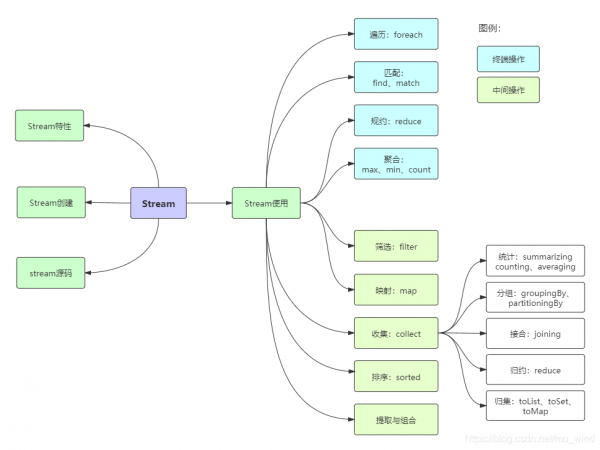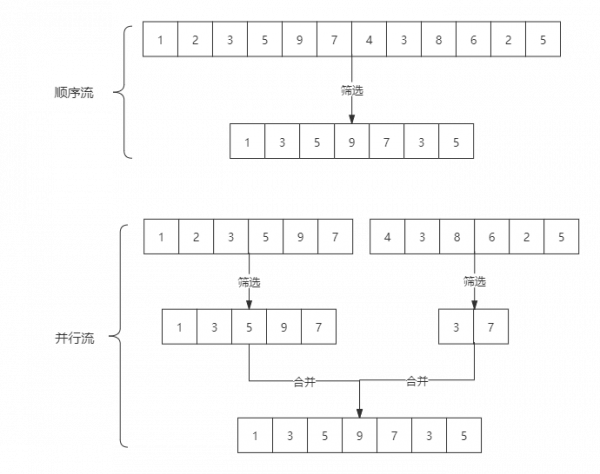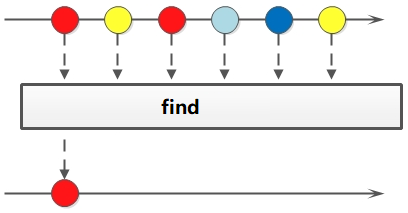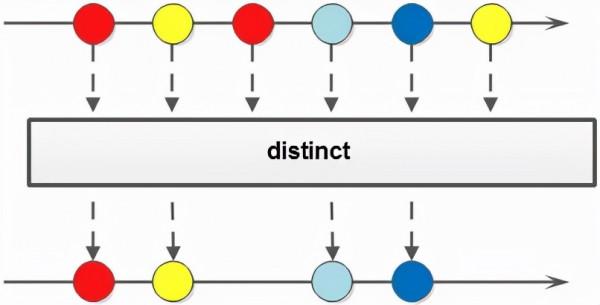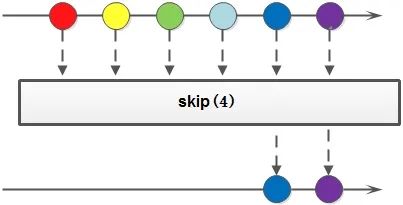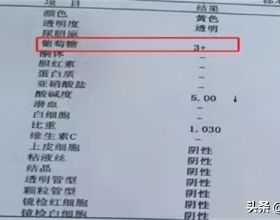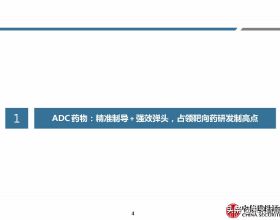先貼上幾個案例,水平高超的同學可以挑戰一下:
1. 從員工集合中篩選出salary大於8000的員工,並放置到新的集合裡。
2. 統計員工的最高薪資、平均薪資、薪資之和。
3. 將員工按薪資從高到低排序,同樣薪資者年齡小者在前。
4. 將員工按性別分類,將員工按性別和地區分類,將員工按薪資是否高於8000分為兩部分。
用傳統的迭代處理也不是很難,但程式碼就顯得冗餘了,跟Stream相比高下立判。Java 8 是一個非常成功的版本,這個版本新增的Stream,配合同版本出現的 Lambda ,給我們操作集合(Collection)提供了極大的便利。
更多 Java實戰教程可以關注微信公眾號「Java後端」,搜尋 Java 關鍵字即可。
那麼什麼是Stream?
Stream將要處理的元素集合看作一種流,在流的過程中,藉助Stream API對流中的元素進行操作,比如:篩選、排序、聚合等。
Stream可以由陣列或集合建立,對流的操作分為兩種:
1. 中間操作,每次返回一個新的流,可以有多個。
2. 終端操作,每個流只能進行一次終端操作,終端操作結束後流無法再次使用。終端操作會產生一個新的集合或值。
另外,Stream有幾個特性:
1. stream不儲存資料,而是按照特定的規則對資料進行計算,一般會輸出結果。
2. stream不會改變資料來源,通常情況下會產生一個新的集合或一個值。
3. stream具有延遲執行特性,只有呼叫終端操作時,中間操作才會執行。
Stream可以透過集合陣列建立。
1、透過 java.util.Collection.stream() 方法用集合建立流
List<String> list = Arrays.asList("a", "b", "c");
// 建立一個順序流
Stream<String> stream = list.stream();
// 建立一個並行流
Stream<String> parallelStream = list.parallelStream();
2、使用java.util.Arrays.stream(T[] array)方法用陣列建立流
int[] array={1,3,5,6,8};
IntStream stream = Arrays.stream(array);
3、使用Stream的靜態方法:of()、iterate()、generate()
Stream<Integer> stream = Stream.of(1, 2, 3, 4, 5, 6);
Stream<Integer> stream2 = Stream.iterate(0, (x) -> x + 3).limit(4);
stream2.forEach(System.out::println);
Stream<Double> stream3 = Stream.generate(Math::random).limit(3);
stream3.forEach(System.out::println);
輸出結果:
0 3 6 9
0.6796156909271994
0.1914314208854283
0.8116932592396652
stream和parallelStream的簡單區分: stream是順序流,由主執行緒按順序對流執行操作,而parallelStream是並行流,內部以多執行緒並行執行的方式對流進行操作,但前提是流中的資料處理沒有順序要求。例如篩選集合中的奇數,兩者的處理不同之處:
如果流中的資料量足夠大,並行流可以加快處速度。除了直接建立並行流,還可以透過parallel()把順序流轉換成並行流:
Optional<Integer> findFirst = list.stream().parallel().filter(x->x>6).findFirst();
在使用stream之前,先理解一個概念:Optional 。
Optional類是一個可以為null的容器物件。如果值存在則isPresent()方法會返回true,呼叫get()方法會返回該物件。
更詳細說明請見:菜鳥教程Java 8 Optional類
接下來,大批程式碼向你襲來!我將用20個案例將Stream的使用整得明明白白,只要跟著敲一遍程式碼,就能很好地掌握。
案例使用的員工類
這是後面案例中使用的員工類:
List<Person> personList = new ArrayList<Person>();
personList.add(new Person("Tom", 8900, "male", "New York"));
personList.add(new Person("Jack", 7000, "male", "Washington"));
personList.add(new Person("Lily", 7800, "female", "Washington"));
personList.add(new Person("Anni", 8200, "female", "New York"));
personList.add(new Person("Owen", 9500, "male", "New York"));
personList.add(new Person("Alisa", 7900, "female", "New York"));
class Person {
private String name; // 姓名
private int salary; // 薪資
private int age; // 年齡
private String sex; //性別
private String area; // 地區
// 構造方法
public Person(String name, int salary, int age,String sex,String area) {
this.name = name;
this.salary = salary;
this.age = age;
this.sex = sex;
this.area = area;
}
// 省略了get和set,請自行新增
}
3.1 遍歷/匹配(foreach/find/match)
Stream也是支援類似集合的遍歷和匹配元素的,只是Stream中的元素是以Optional型別存在的。Stream的遍歷、匹配非常簡單。
// import已省略,請自行新增,後面程式碼亦是
public class StreamTest {
public static void main(String[] args) {
List<Integer> list = Arrays.asList(7, 6, 9, 3, 8, 2, 1);
// 遍歷輸出符合條件的元素
list.stream().filter(x -> x > 6).forEach(System.out::println);
// 匹配第一個
Optional<Integer> findFirst = list.stream().filter(x -> x > 6).findFirst();
// 匹配任意(適用於並行流)
Optional<Integer> findAny = list.parallelStream().filter(x -> x > 6).findAny();
// 是否包含符合特定條件的元素
boolean anyMatch = list.stream().anyMatch(x -> x < 6);
System.out.println("匹配第一個值:" + findFirst.get());
System.out.println("匹配任意一個值:" + findAny.get());
System.out.println("是否存在大於6的值:" + anyMatch);
}
}
3.2 篩選(filter)
篩選,是按照一定的規則校驗流中的元素,將符合條件的元素提取到新的流中的操作。
案例一:篩選出Integer集合中大於7的元素,並打印出來
public class StreamTest {
public static void main(String[] args) {
List<Integer> list = Arrays.asList(6, 7, 3, 8, 1, 2, 9);
Stream<Integer> stream = list.stream();
stream.filter(x -> x > 7).forEach(System.out::println);
}
}
預期結果:
8 9
案例二:篩選員工中工資高於8000的人,並形成新的集合。 形成新集合依賴collect(收集),後文有詳細介紹。
public class StreamTest {
public static void main(String[] args) {
List<Person> personList = new ArrayList<Person>();
personList.add(new Person("Tom", 8900, 23, "male", "New York"));
personList.add(new Person("Jack", 7000, 25, "male", "Washington"));
personList.add(new Person("Lily", 7800, 21, "female", "Washington"));
personList.add(new Person("Anni", 8200, 24, "female", "New York"));
personList.add(new Person("Owen", 9500, 25, "male", "New York"));
personList.add(new Person("Alisa", 7900, 26, "female", "New York"));
List<String> fiterList = personList.stream().filter(x -> x.getSalary() > 8000).map(Person::getName)
.collect(Collectors.toList());
System.out.print("高於8000的員工姓名:" + fiterList);
}
}
執行結果:
高於8000的員工姓名:[Tom, Anni, Owen]
3.3 聚合(max/min/count)
max、min、count這些字眼你一定不陌生,沒錯,在mysql中我們常用它們進行資料統計。Java stream中也引入了這些概念和用法,極大地方便了我們對集合、陣列的資料統計工作。
案例一:獲取String集合中最長的元素。
public class StreamTest {
public static void main(String[] args) {
List<String> list = Arrays.asList("adnm", "admmt", "pot", "xbangd", "weoujgsd");
Optional<String> max = list.stream().max(Comparator.comparing(String::length));
System.out.println("最長的字串:" + max.get());
}
}
輸出結果:
最長的字串:weoujgsd
案例二:獲取Integer集合中的最大值。
public class StreamTest {
public static void main(String[] args) {
List<Integer> list = Arrays.asList(7, 6, 9, 4, 11, 6);
// 自然排序
Optional<Integer> max = list.stream().max(Integer::compareTo);
// 自定義排序
Optional<Integer> max2 = list.stream().max(new Comparator<Integer>() {
@Override
public int compare(Integer o1, Integer o2) {
return o1.compareTo(o2);
}
});
System.out.println("自然排序的最大值:" + max.get());
System.out.println("自定義排序的最大值:" + max2.get());
}
}
輸出結果:
自然排序的最大值:11
自定義排序的最大值:11
案例三:獲取員工工資最高的人。
public class StreamTest {
public static void main(String[] args) {
List<Person> personList = new ArrayList<Person>();
personList.add(new Person("Tom", 8900, 23, "male", "New York"));
personList.add(new Person("Jack", 7000, 25, "male", "Washington"));
personList.add(new Person("Lily", 7800, 21, "female", "Washington"));
personList.add(new Person("Anni", 8200, 24, "female", "New York"));
personList.add(new Person("Owen", 9500, 25, "male", "New York"));
personList.add(new Person("Alisa", 7900, 26, "female", "New York"));
Optional<Person> max = personList.stream().max(Comparator.comparingInt(Person::getSalary));
System.out.println("員工工資最大值:" + max.get().getSalary());
}
}
輸出結果:
員工工資最大值:9500
案例四:計算Integer集合中大於6的元素的個數。
import java.util.Arrays;
import java.util.List;
public class StreamTest {
public static void main(String[] args) {
List<Integer> list = Arrays.asList(7, 6, 4, 8, 2, 11, 9);
long count = list.stream().filter(x -> x > 6).count();
System.out.println("list中大於6的元素個數:" + count);
}
}
輸出結果:
list中大於6的元素個數:4
3.4 對映(map/flatMap)
對映,可以將一個流的元素按照一定的對映規則對映到另一個流中。分為map和flatMap:
- map:接收一個函式作為引數,該函式會被應用到每個元素上,並將其對映成一個新的元素。
- flatMap:接收一個函式作為引數,將流中的每個值都換成另一個流,然後把所有流連線成一個流。
案例一:英文字串陣列的元素全部改為大寫。整數陣列每個元素+3。
public class StreamTest {
public static void main(String[] args) {
String[] strArr = { "abcd", "bcdd", "defde", "fTr" };
List<String> strList = Arrays.stream(strArr).map(String::toUpperCase).collect(Collectors.toList());
List<Integer> intList = Arrays.asList(1, 3, 5, 7, 9, 11);
List<Integer> intListNew = intList.stream().map(x -> x + 3).collect(Collectors.toList());
System.out.println("每個元素大寫:" + strList);
System.out.println("每個元素+3:" + intListNew);
}
}
輸出結果:
每個元素大寫:[ABCD, BCDD, DEFDE, FTR]
每個元素+3:[4, 6, 8, 10, 12, 14]
案例二:將員工的薪資全部增加1000。
public class StreamTest {
public static void main(String[] args) {
List<Person> personList = new ArrayList<Person>();
personList.add(new Person("Tom", 8900, 23, "male", "New York"));
personList.add(new Person("Jack", 7000, 25, "male", "Washington"));
personList.add(new Person("Lily", 7800, 21, "female", "Washington"));
personList.add(new Person("Anni", 8200, 24, "female", "New York"));
personList.add(new Person("Owen", 9500, 25, "male", "New York"));
personList.add(new Person("Alisa", 7900, 26, "female", "New York"));
// 不改變原來員工集合的方式
List<Person> personListNew = personList.stream().map(person -> {
Person personNew = new Person(person.getName(), 0, 0, null, null);
personNew.setSalary(person.getSalary() + 10000);
return personNew;
}).collect(Collectors.toList());
System.out.println("一次改動前:" + personList.get(0).getName() + "-->" + personList.get(0).getSalary());
System.out.println("一次改動後:" + personListNew.get(0).getName() + "-->" + personListNew.get(0).getSalary());
// 改變原來員工集合的方式
List<Person> personListNew2 = personList.stream().map(person -> {
person.setSalary(person.getSalary() + 10000);
return person;
}).collect(Collectors.toList());
System.out.println("二次改動前:" + personList.get(0).getName() + "-->" + personListNew.get(0).getSalary());
System.out.println("二次改動後:" + personListNew2.get(0).getName() + "-->" + personListNew.get(0).getSalary());
}
}
輸出結果:
一次改動前:Tom–>8900
一次改動後:Tom–>18900
二次改動前:Tom–>18900
二次改動後:Tom–>18900
案例三:將兩個字元數組合併成一個新的字元陣列。
public class StreamTest {
public static void main(String[] args) {
List<String> list = Arrays.asList("m,k,l,a", "1,3,5,7");
List<String> listNew = list.stream().flatMap(s -> {
// 將每個元素轉換成一個stream
String[] split = s.split(",");
Stream<String> s2 = Arrays.stream(split);
return s2;
}).collect(Collectors.toList());
System.out.println("處理前的集合:" + list);
System.out.println("處理後的集合:" + listNew);
}
}
輸出結果:
處理前的集合:[m-k-l-a, 1-3-5]
處理後的集合:[m, k, l, a, 1, 3, 5]
3.5 歸約(reduce)
歸約,也稱縮減,顧名思義,是把一個流縮減成一個值,能實現對集合求和、求乘積和求最值操作。
案例一:求Integer集合的元素之和、乘積和最大值。
public class StreamTest {
public static void main(String[] args) {
List<Integer> list = Arrays.asList(1, 3, 2, 8, 11, 4);
// 求和方式1
Optional<Integer> sum = list.stream().reduce((x, y) -> x + y);
// 求和方式2
Optional<Integer> sum2 = list.stream().reduce(Integer::sum);
// 求和方式3
Integer sum3 = list.stream().reduce(0, Integer::sum);
// 求乘積
Optional<Integer> product = list.stream().reduce((x, y) -> x * y);
// 求最大值方式1
Optional<Integer> max = list.stream().reduce((x, y) -> x > y ? x : y);
// 求最大值寫法2
Integer max2 = list.stream().reduce(1, Integer::max);
System.out.println("list求和:" + sum.get() + "," + sum2.get() + "," + sum3);
System.out.println("list求積:" + product.get());
System.out.println("list求和:" + max.get() + "," + max2);
}
}
輸出結果:
list求和:29,29,29
list求積:2112
list求和:11,11
案例二:求所有員工的工資之和和最高工資。
public class StreamTest {
public static void main(String[] args) {
List<Person> personList = new ArrayList<Person>();
personList.add(new Person("Tom", 8900, 23, "male", "New York"));
personList.add(new Person("Jack", 7000, 25, "male", "Washington"));
personList.add(new Person("Lily", 7800, 21, "female", "Washington"));
personList.add(new Person("Anni", 8200, 24, "female", "New York"));
personList.add(new Person("Owen", 9500, 25, "male", "New York"));
personList.add(new Person("Alisa", 7900, 26, "female", "New York"));
// 求工資之和方式1:
Optional<Integer> sumSalary = personList.stream().map(Person::getSalary).reduce(Integer::sum);
// 求工資之和方式2:
Integer sumSalary2 = personList.stream().reduce(0, (sum, p) -> sum += p.getSalary(),
(sum1, sum2) -> sum1 + sum2);
// 求工資之和方式3:
Integer sumSalary3 = personList.stream().reduce(0, (sum, p) -> sum += p.getSalary(), Integer::sum);
// 求最高工資方式1:
Integer maxSalary = personList.stream().reduce(0, (max, p) -> max > p.getSalary() ? max : p.getSalary(),
Integer::max);
// 求最高工資方式2:
Integer maxSalary2 = personList.stream().reduce(0, (max, p) -> max > p.getSalary() ? max : p.getSalary(),
(max1, max2) -> max1 > max2 ? max1 : max2);
System.out.println("工資之和:" + sumSalary.get() + "," + sumSalary2 + "," + sumSalary3);
System.out.println("最高工資:" + maxSalary + "," + maxSalary2);
}
}
輸出結果:
工資之和:49300,49300,49300
最高工資:9500,9500
3.6 收集(collect)
collect,收集,可以說是內容最繁多、功能最豐富的部分了。從字面上去理解,就是把一個流收集起來,最終可以是收整合一個值也可以收整合一個新的集合。
collect主要依賴java.util.stream.Collectors類內建的靜態方法。
3.6.1 歸集(toList/toSet/toMap)
因為流不儲存資料,那麼在流中的資料完成處理後,需要將流中的資料重新歸集到新的集合裡。toList、toSet和toMap比較常用,另外還有toCollection、toConcurrentMap等複雜一些的用法。
下面用一個案例演示toList、toSet和toMap:
public class StreamTest {
public static void main(String[] args) {
List<Integer> list = Arrays.asList(1, 6, 3, 4, 6, 7, 9, 6, 20);
List<Integer> listNew = list.stream().filter(x -> x % 2 == 0).collect(Collectors.toList());
Set<Integer> set = list.stream().filter(x -> x % 2 == 0).collect(Collectors.toSet());
List<Person> personList = new ArrayList<Person>();
personList.add(new Person("Tom", 8900, 23, "male", "New York"));
personList.add(new Person("Jack", 7000, 25, "male", "Washington"));
personList.add(new Person("Lily", 7800, 21, "female", "Washington"));
personList.add(new Person("Anni", 8200, 24, "female", "New York"));
Map<?, Person> map = personList.stream().filter(p -> p.getSalary() > 8000)
.collect(Collectors.toMap(Person::getName, p -> p));
System.out.println("toList:" + listNew);
System.out.println("toSet:" + set);
System.out.println("toMap:" + map);
}
}
執行結果:
toList:[6, 4, 6, 6, 20]
toSet:[4, 20, 6]
toMap:{Tom=mutest.Person@5fd0d5ae, Anni=mutest.Person@2d98a335}
3.6.2 統計(count/averaging)
Collectors提供了一系列用於資料統計的靜態方法:
- 計數:count
- 平均值:averagingInt、averagingLong、averagingDouble
- 最值:maxBy、minBy
- 求和:summingInt、summingLong、summingDouble
- 統計以上所有:summarizingInt、summarizingLong、summarizingDouble
案例:統計員工人數、平均工資、工資總額、最高工資。
public class StreamTest {
public static void main(String[] args) {
List<Person> personList = new ArrayList<Person>();
personList.add(new Person("Tom", 8900, 23, "male", "New York"));
personList.add(new Person("Jack", 7000, 25, "male", "Washington"));
personList.add(new Person("Lily", 7800, 21, "female", "Washington"));
// 求總數
Long count = personList.stream().collect(Collectors.counting());
// 求平均工資
Double average = personList.stream().collect(Collectors.averagingDouble(Person::getSalary));
// 求最高工資
Optional<Integer> max = personList.stream().map(Person::getSalary).collect(Collectors.maxBy(Integer::compare));
// 求工資之和
Integer sum = personList.stream().collect(Collectors.summingInt(Person::getSalary));
// 一次性統計所有資訊
DoubleSummaryStatistics collect = personList.stream().collect(Collectors.summarizingDouble(Person::getSalary));
System.out.println("員工總數:" + count);
System.out.println("員工平均工資:" + average);
System.out.println("員工工資總和:" + sum);
System.out.println("員工工資所有統計:" + collect);
}
}
執行結果:
員工總數:3
員工平均工資:7900.0
員工工資總和:23700
員工工資所有統計:DoubleSummaryStatistics{count=3, sum=23700.000000,min=7000.000000, average=7900.000000, max=8900.000000}
3.6.3 分組(partitioningBy/groupingBy)
- 分割槽:將stream按條件分為兩個Map,比如員工按薪資是否高於8000分為兩部分。
- 分組:將集合分為多個Map,比如員工按性別分組。有單級分組和多級分組。
案例:將員工按薪資是否高於8000分為兩部分;將員工按性別和地區分組
public class StreamTest {
public static void main(String[] args) {
List<Person> personList = new ArrayList<Person>();
personList.add(new Person("Tom", 8900, "male", "New York"));
personList.add(new Person("Jack", 7000, "male", "Washington"));
personList.add(new Person("Lily", 7800, "female", "Washington"));
personList.add(new Person("Anni", 8200, "female", "New York"));
personList.add(new Person("Owen", 9500, "male", "New York"));
personList.add(new Person("Alisa", 7900, "female", "New York"));
// 將員工按薪資是否高於8000分組
Map<Boolean, List<Person>> part = personList.stream().collect(Collectors.partitioningBy(x -> x.getSalary() > 8000));
// 將員工按性別分組
Map<String, List<Person>> group = personList.stream().collect(Collectors.groupingBy(Person::getSex));
// 將員工先按性別分組,再按地區分組
Map<String, Map<String, List<Person>>> group2 = personList.stream().collect(Collectors.groupingBy(Person::getSex, Collectors.groupingBy(Person::getArea)));
System.out.println("員工按薪資是否大於8000分組情況:" + part);
System.out.println("員工按性別分組情況:" + group);
System.out.println("員工按性別、地區:" + group2);
}
}
輸出結果:
員工按薪資是否大於8000分組情況:{false=[mutest.Person@2d98a335, mutest.Person@16b98e56, mutest.Person@7ef20235], true=[mutest.Person@27d6c5e0, mutest.Person@4f3f5b24, mutest.Person@15aeb7ab]}
員工按性別分組情況:{female=[mutest.Person@16b98e56, mutest.Person@4f3f5b24, mutest.Person@7ef20235], male=[mutest.Person@27d6c5e0, mutest.Person@2d98a335, mutest.Person@15aeb7ab]}
員工按性別、地區:{female={New York=[mutest.Person@4f3f5b24, mutest.Person@7ef20235], Washington=[mutest.Person@16b98e56]}, male={New York=[mutest.Person@27d6c5e0, mutest.Person@15aeb7ab], Washington=[mutest.Person@2d98a335]}}
3.6.4 接合(joining)
joining可以將stream中的元素用特定的連線符(沒有的話,則直接連線)連線成一個字串。
public class StreamTest {
public static void main(String[] args) {
List<Person> personList = new ArrayList<Person>();
personList.add(new Person("Tom", 8900, 23, "male", "New York"));
personList.add(new Person("Jack", 7000, 25, "male", "Washington"));
personList.add(new Person("Lily", 7800, 21, "female", "Washington"));
String names = personList.stream().map(p -> p.getName()).collect(Collectors.joining(","));
System.out.println("所有員工的姓名:" + names);
List<String> list = Arrays.asList("A", "B", "C");
String string = list.stream().collect(Collectors.joining("-"));
System.out.println("拼接後的字串:" + string);
}
}
執行結果:
所有員工的姓名:Tom,Jack,Lily
拼接後的字串:A-B-C
3.6.5 歸約(reducing)
Collectors類提供的reducing方法,相比於stream本身的reduce方法,增加了對自定義歸約的支援。
public class StreamTest {
public static void main(String[] args) {
List<Person> personList = new ArrayList<Person>();
personList.add(new Person("Tom", 8900, 23, "male", "New York"));
personList.add(new Person("Jack", 7000, 25, "male", "Washington"));
personList.add(new Person("Lily", 7800, 21, "female", "Washington"));
// 每個員工減去起徵點後的薪資之和(這個例子並不嚴謹,但一時沒想到好的例子)
Integer sum = personList.stream().collect(Collectors.reducing(0, Person::getSalary, (i, j) -> (i + j - 5000)));
System.out.println("員工扣稅薪資總和:" + sum);
// stream的reduce
Optional<Integer> sum2 = personList.stream().map(Person::getSalary).reduce(Integer::sum);
System.out.println("員工薪資總和:" + sum2.get());
}
}
執行結果:
員工扣稅薪資總和:8700
員工薪資總和:23700
3.7 排序(sorted)
sorted,中間操作。有兩種排序:
- sorted():自然排序,流中元素需實現Comparable介面
- sorted(Comparator com):Comparator排序器自定義排序
案例:將員工按工資由高到低(工資一樣則按年齡由大到小)排序
public class StreamTest {
public static void main(String[] args) {
List<Person> personList = new ArrayList<Person>();
personList.add(new Person("Sherry", 9000, 24, "female", "New York"));
personList.add(new Person("Tom", 8900, 22, "male", "Washington"));
personList.add(new Person("Jack", 9000, 25, "male", "Washington"));
personList.add(new Person("Lily", 8800, 26, "male", "New York"));
personList.add(new Person("Alisa", 9000, 26, "female", "New York"));
// 按工資升序排序(自然排序)
List<String> newList = personList.stream().sorted(Comparator.comparing(Person::getSalary)).map(Person::getName)
.collect(Collectors.toList());
// 按工資倒序排序
List<String> newList2 = personList.stream().sorted(Comparator.comparing(Person::getSalary).reversed())
.map(Person::getName).collect(Collectors.toList());
// 先按工資再按年齡升序排序
List<String> newList3 = personList.stream()
.sorted(Comparator.comparing(Person::getSalary).thenComparing(Person::getAge)).map(Person::getName)
.collect(Collectors.toList());
// 先按工資再按年齡自定義排序(降序)
List<String> newList4 = personList.stream().sorted((p1, p2) -> {
if (p1.getSalary() == p2.getSalary()) {
return p2.getAge() - p1.getAge();
} else {
return p2.getSalary() - p1.getSalary();
}
}).map(Person::getName).collect(Collectors.toList());
System.out.println("按工資升序排序:" + newList);
System.out.println("按工資降序排序:" + newList2);
System.out.println("先按工資再按年齡升序排序:" + newList3);
System.out.println("先按工資再按年齡自定義降序排序:" + newList4);
}
}
執行結果:
按工資升序排序:[Lily, Tom, Sherry, Jack, Alisa]
按工資降序排序:[Sherry, Jack, Alisa, Tom, Lily]
先按工資再按年齡升序排序:[Lily, Tom, Sherry, Jack, Alisa]
先按工資再按年齡自定義降序排序:[Alisa, Jack, Sherry, Tom, Lily]
3.8 提取/組合
流也可以進行合併、去重、限制、跳過等操作。
public class StreamTest {
public static void main(String[] args) {
String[] arr1 = { "a", "b", "c", "d" };
String[] arr2 = { "d", "e", "f", "g" };
Stream<String> stream1 = Stream.of(arr1);
Stream<String> stream2 = Stream.of(arr2);
// concat:合併兩個流 distinct:去重
List<String> newList = Stream.concat(stream1, stream2).distinct().collect(Collectors.toList());
// limit:限制從流中獲得前n個數據
List<Integer> collect = Stream.iterate(1, x -> x + 2).limit(10).collect(Collectors.toList());
// skip:跳過前n個數據
List<Integer> collect2 = Stream.iterate(1, x -> x + 2).skip(1).limit(5).collect(Collectors.toList());
System.out.println("流合併:" + newList);
System.out.println("limit:" + collect);
System.out.println("skip:" + collect2);
}
}
執行結果:
流合併:[a, b, c, d, e, f, g]
limit:[1, 3, 5, 7, 9, 11, 13, 15, 17, 19]
skip:[3, 5, 7, 9, 11]
好,以上就是全部內容,能堅持看到這裡,你一定很有收穫。
作者:雲深i不知處
https://blog.csdn.net/mu_wind/article/details/109516995

